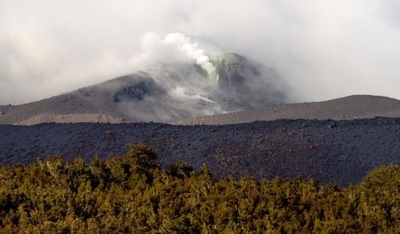Second New Zealand Volcano 'Burps' After Eruption

A second volcano in New Zealand threatened to rumble to life on Wednesday, a day after a long-dormant mountain that was the backdrop to "The Lord of the Rings" movies erupted.
GNS Science reported no fresh convulsions at the Mount Tongariro volcano, which sent a plume of ash 20,000 feet (6,100 meters) into the atmosphere, showering the North Island and disrupting domestic air travel.
But a monitoring camera showed the volcanic White Island, just off the coast of North Island, had experienced a small eruption that was probably unrelated to Tongariro, said Craig Miller, a volcanologist with GNS, the official monitoring body.
"The crater-rim camera appears to be splattered with mud/ash this morning, so it seems there has been some kind of burp," he said.
Around the remote Tongariro volcano -- which officials say could erupt again without warning at any time -- residents cleaned up the ash that spewed early Tuesday.
Heavy rain washed away much of the fine silt, causing streams to run grey, but residents said the powdery substance seeped into homes even when doors and windows were sealed.
Air travel, which was disrupted across much of the North Island because of the risk posed by volcanic ash, returned to normal, as the remnants of the cloud washed out to sea overnight.
In Wellington, more than 250 kilometers (155 miles) from the volcano, a smell of sulfur from gases expelled by the volcano hung in the air for most of the morning.
"It was like sewage, really unpleasant," Wellington resident Carole Burke said. "It was so strong I thought Tongariro must have gone off again."
There were no injuries from the eruption, which officials said hurled boulders up to two kilometers from the volcano crater, destroying a hut used by hikers which, by chance, was unoccupied at the time.
Images released by GNS Science showed vents in the side of the ash-covered mountain still steaming and a stream valley choked with rocks and soil disturbed by the eruption.
Until this week, the volcano had been inactive since 1897 and scientists said they had no warning it was about to blow.
Amid fears the mountain is entering a new and dangerous phase of volcanic activity, officials closed hiking tracks in the national park that surrounds the peak until further notice.
However, the nearby Ruapehu ski fields were still operating, with winter sports enthusiasts such as Hiro Yashima from Japan unfazed by the eruption.
"I heard that the mountain went boom, so I'm ready with my camera in case it goes boom again," he told Fairfax Media.
New Zealand lies on the so-called "Pacific Ring of Fire", where the Earth's tectonic plates collide, making it a hotspot for earthquakes and volcanic activity.
One of the country's deadliest disasters occurred in 1953, when debris from an eruption at Mount Ruapehu, also in central North Island, downed a rail bridge, leading to a train derailment that claimed 151 lives.
Mount Tarawera, in the same area, erupted in 1886, with a death toll estimated at 120-150 people.
GNS describes White Island as New Zealand's most active volcano and says in 1914 there was a landslide there caused by volcanic activity which killed 11 men at a sulfur mine.



